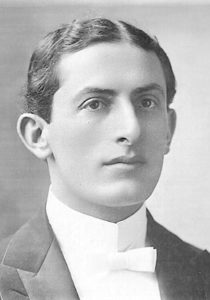People
Notable People
Moses Gries - Rabbi of Temple–Tifereth Israel
10311 Lake Shore Boulevard

Rabbi Moses Gries, a proponent of Classical Reform Judaism, served as the spiritual leader of the Temple for twenty-five years. His sanctuary was recognized as the first “open temple” or institutional church established by Jewish people in the world, where all those interested in religious, educational, cultural activities are welcomed. Rabbi Gries’ liberal social services attracted nationwide attention.
Gries, whose family was of Austro-Hungarian background, was born on January 25, 1868, in Newark, New Jersey, the son of Jacob and Katie Gries. He attended Hughes High School in Cincinnati, the University of Cincinnati, and Hebrew Union College, graduating in 1889 and receiving ordination in 1889.
Gries’s first rabbinical position was in Chattanooga, Tennessee. On November 20, 1892, he succeeded Rabbi Aaron Hahn at The Temple. Gries became the first native-born Hebrew Union College-educated rabbi to serve in Cleveland. During his first eight years at the Temple, he affected radical changes in the congregation. All vestiges of German were discarded, the Union Prayer Book was adopted; Sabbath morning services were moved from Saturday to Sunday; English was substituted for Hebrew in Torah readings and most prayers, and Hebrew was removed from the religious school curriculum.
Gries’s religious philosophy was that Reform Judaism should be Americanized. In keeping with most Protestant denominations at the turn of the 20th century, Gries created various congregational groups and services, including the Temple Women’s Association, the Temple Library, the Temple Alumni Association, the Educational League, the Temple Orchestra, and the Temple Society.
Gries was a political and social progressive, instilled with the philosophy of the social gospel. He had close ties with the liberal Protestant clergy of the city and was active in ecumenical affairs. He believed it was incumbent on the wealthy to use their money for the common good in charitable and benevolent activities and civic improvement. In 1897, he advocated for building a city hall, city library, art museum, and public auditorium.
He was one of the small groups that founded the Citizens League of Greater Cleveland and was active in ecumenical affairs. In addition, Gries took an active part in the communal affairs of Cleveland Jewry. For example, he was instrumental in founding the Council Educational Alliance, a settlement house established by the National Council of Jewish Women, Cleveland Section, in 1899.
In 1897, Gries called for a general federation of charities to consolidate and coordinate charitable efforts in the community. When the Federation for Jewish Charities was established in 1903, he became one of its most active members.
Gries led local protests against pogroms in Eastern Europe and urged social welfare work among the newly arrived Jewish immigrants. At the same time, he remained far removed from the predominantly Orthodox Yiddish-speaking immigrants. In 1907, he denounced Zionism, gaining considerable strength in Cleveland among the East European immigrants. He believed political Zionism raised unwanted questions concerning Jewish identity and loyalty. Moreover, he argued that Zionism raised the issue of dual loyalty, which threatened the security of the Jewish community in America.
Moses Gries was president of the Central Conference of American Rabbis and Hebrew Union College. He was a member of the Cleveland Chamber of Commerce committee on Municipal Arts and Architecture, a member of the Cleveland Associated Charities board of trustees, a Cleveland School of Art trustee, a Federation of Jewish Charities trustee, and a City Club of Cleveland director. He was a past president of the Educational League, B’nai B’rith, Council of Jewish Women, Alumni Association of the Hebrew Union College, Ohio's Jewish Religious Education Association, and the Ohio Rabbinical Association.
Moses Gries married Francis (Fannie) Hays on June 15, 1898. She was born on December 4, 1876, the daughter of Kaufman and Lizzie Hays. During World War I, Fannie served in the Bratenahl Red Cross and canteen service. She was a member of the Cuyahoga County Republican Executive committee, Council Educational Alliance, and honorary trustee of the Council of Jewish Women and Temple Women’s Association.
For health reasons, Gries resigned from the Temple in 1917. He died a year later, on October 30, 1918. Fanny died on June 8, 1933, in New York City. Both were buried in Mayfield Cemetery.
Moses and Fannie had two sons: Robert Hays born on October 12, 1900, and Lincon Hays born on July 19, 1905. Both attended the Bratenahl School. Lincoln Gries recalled climbing to the second floor of their home by an outside ladder because the interior stairways were unfinished.
